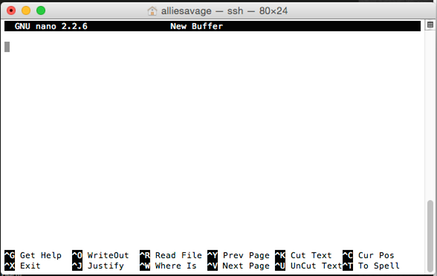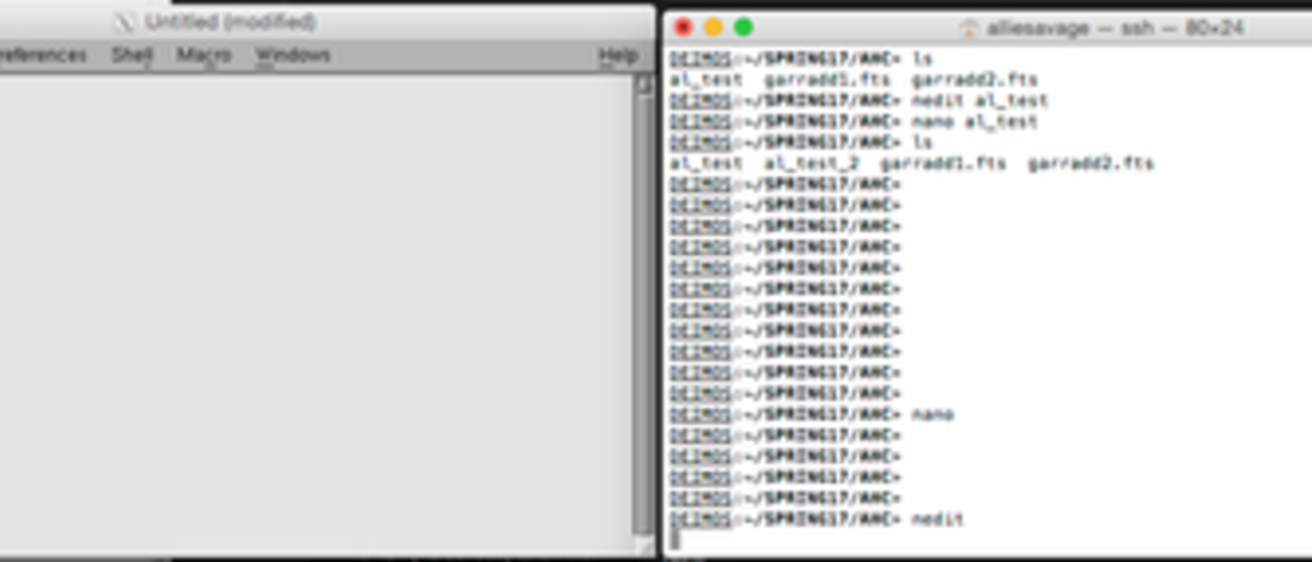Opening Editor Programs on Deimos
To edit or make a text file, a variety of command line editors can be used.
Two such editors are:

To call either in the command line and open a new file, type in a new line the programs name (e.g., nedit)
If you want to open pre-existing file, then type: nano filename
Each program is a different. To exit nano, for example, your use CTRL+X to exit, whereas nedit can be closed from a drop down menu.
Format of File
The substance of the observing file should follow the example given below.

- You should give a title, observer email, and priority level in the first lines. The pound-sign (#) is a commented-out line, meaning it functions as a commenting line only and does not actually run. Generally, you should put the priority level to 10, unless you have “ this time and night only” priority, in which case 5 can be used.
- The first column in the 6th-9th rows is always ‘source’. The second column is the name of the source in quotations. If possible, you should match your source name to the catalog name.
- End with ‘/‘ to line return. There needs to be a space between the last character and the /.
Accepted Keywords
| Source | String | Short, but detailed Name of Target Object |
|---|---|---|
| ra | hh:mm:ss | ra of target (Ex: 01:30:05.54) |
| dec | dd:mm:ss | dec of target (Ex: +06:02:59.1) |
| epoch | 2000 | Specify once between Priority line and first observation line |
| filter | r | See filter codes below. Multiple filters can be specified separated by commas but no spaces. (Ex: filter r,r,g,g or r,g,b,6) |
| dur | integer | duration of observations in seconds. If specifying multiple filter codes, then multiple durations must be given. (Ex: dur 30,30,40,40 or 30,40,150,300) |
| repeat | integer | Sets the number of repeats for a given line. (Ex: repeat 5) |
| cadence | hh:mm:ss | Sets time delay of repeated observations. (Ex: cadence 01:00:00) |
| LSTSTART | hh:mm:ss | Specifies a start time for the observations in lst. |
| UTSTART | hh:mm:ss | Specifies a start time in UT time. UTDATE no currently supported. |
Notes and Examples
Application of LSTSTART + Repeat + Cadence
Specifying an LSTSTART or UTSTART + repeat + cadence, such as:
source ‘M67’ filter r,g dur 30,30 lststart 01:05:00 repeat 5 cadence 00:10:00 /
would BEGIN the observation at the given lststart. An image in r and g filters of 30s exposure would be taken from the lststart time every 10 minutes until 5 such observations were completed.
Application of LSTSTART + Repeat
Specifying an LSTSTART or UTSTART + repeat, such as
source ‘M67’ filter r,g dur 30,30 lststart 01:05:00 repeat 5 /
would put one set of r and g observations at the lststart and then populate 4 subsequent sets of observations on either side of the lststart. Thus, the total observation would actually start at approximately 01:03:00 and end at 01:07:00 (neglecting upload time from the telescope).
Application of Repeat + Cadence
Specifying a repeat+cadence, such as
source ‘M67’ filter r,g dur 30,30 cadence 00:10:00 repeat 5 /
would result in 5 sets of r and g images separated by 10 minutes. The observations would be centered at the time closest to transit, or what the schedule allows.
Schedules should be place in /usr/local/telescope/user/schedin/netin/ on the day of observation with the file named XXX000.sch, where the observer should replace XXX with their 3 character observing code and 000 with the day since Jan 1st. Example, a January 5th observation would get xxx005.sch name.
Since UTDATE is not supported, all files submitted will be put on the schedule the day they appear in the folder. Once on the daily schedule, they are discarded before the next day even if the observation wasn’t complete. This means that multi day observations or observations for future dates are not possible without first communicating with the telescope scheduler.
Filter Codes
| Filter | Code | Notes |
|---|---|---|
| None | N | No filter |
| Red | X | 625 nm-690 nm; Used for making tri-color images |
| Visual | V | Used for making tri-color images |
| Blue | B | Used for making tri-color images |
| 300 Grism | 3 | 300 line per mm grim |
| H alpha | H | 656.3 nm |
| Oxygen III | O | 500.7 nm |
| Sulfur II | S | 671.6 nm |
| Longpass | W | 650 nm and up |
| Sloan g' | G | 401-550 nm; Used for photometry |
| Sloan r' | R | 560-695 nm; Used for photometry |
| 600 Grism | 6 | 600 line per mm grism |
